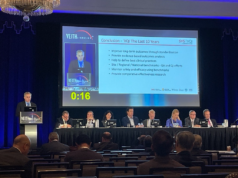
The diagnosis and management of non-thrombotic iliac vein lesions (NIVL) is the focus of a newly published set of consensus statements from the Vascular Interventional Advances (VIVA) Foundation, the American Venous Forum (AVF), and the American Vein and Lymphatic Society (AVLS).
The report, authored by Kush Desai (Northwestern University Feinberg School of Medicine, Chicago, USA) and colleagues, appears as an open access article in the American Heart Association (AHA) journal Circulation: Cardiovascular Interventions.
Imaging considerations for diagnosis, patient selection and technical considerations for stent placement, and optimal post-procedure medical therapy and surveillance are all covered in the document.
On imaging, Desai et al advise: “In a patient considered for NIVL treatment, an invasive diagnosis with the complementary use of venography and IVUS [intravascular ultrasound] is recommended.” In addition to this, the authors stress the importance of “dynamic” IVUS evaluation of NIVL, which they explain includes breath hold and manoeuvres that increase intra-abdominal pressure.
The writing group further advise that intervention below the thresholds of >50% area reduction or >61% diameter stenosis on IVUS at the NIVL is not recommended, and that use of venography thresholds alone for diagnosis and treatment of NIVL is “less well established”.
Finally in this section, Desai and colleagues state that axial imaging with computed tomography (CT) or magnetic resonance imaging (MRI) “can help confirm the presence of anatomy that may be associated with a clinically significant NIVL”. They stress, however, the importance of clinical evaluation and venography and/or IVUS being central to the final diagnosis and intention to treat.
On the topic of patient selection for NIVL stent placement, the authors recommend that stenting “may be appropriate” in certain circumstances, for example in the presence of either asymmetrical oedema significantly affecting quality of life (QoL), progressive Clinical-Etiology-Anatomy-Pathophysiology (CEAP) class 4 to 6 venous disease, or venous claudication with minimal superficial venous disease, or following previous treatment of underlying superficial venous reflux.
The authors warn, however, that stent placement for NIVL is “inappropriate” in patients with minimal to no symptoms and in asymptomatic patients to prevent possible future venous thromboembolism (VTE) events.
In their final recommendation of this section, Desai et al write that stenting “may have a role” in some cases with QoL-impacting chronic pelvic pain of venous origin in the presence of parauterine veins with or without pelvic venous reflux.
The report also includes four consensus recommendations on technical considerations for stent placement, including firstly that the choice of stent size and length in NIVL “should depend on IVUS for diameter/length measurements with compulsory fluoroscopy for length measurements”.
This section of the report also addresses stent migration, which Desai and colleagues highlight can have “devastating consequences”. As a result, the authors stress that measures to mitigate the possibility of stent migration and complications—including appropriate device diameter and length—are “mandatory”.
Desai and colleagues continue that sizing based on the normal reference vessel is “generally recommended” and that stents for NIVL should be extended into the straight portion of the external iliac vein to limit complications including stent migration.
The authors advise against routine use of anticoagulation or antiplatelet therapy for untreated NIVL, opening their recommendations for optimal medical therapy and surveillance for NIVL patients. They go on to highlight that, in treated patients with NIVL with no evidence of previous VTE, there is “no consensus that anticoagulation or antiplatelet therapy is necessary”.
Furthermore, they recommend that an assessment of thrombotic risk in patients with NIVL should be made and, should anticoagulation or antiplatelet therapy be indicated, the agent, dose and duration “should be tailored accordingly”. The final recommendation the authors make in this section is to encourage routine early and long-term clinical surveillance following stent placement.
Finally, the document outlines future direction in research and education on the topic of NIVL diagnosis and management. “Evidence-based appropriateness of treatment and longitudinal management of patients with NIVL should be supported by long-term prospective trials,” Desai et al write, going on to emphasise that these should include outcomes focusing on patient QOL measures. On appropriateness, they detail that this “emphasises patient selection, intervention technique, and post-procedure optimal medical therapy and surveillance”.
Desai and colleagues underline the fact that future directions in NIVL research should include the establishment of consensus guidelines with multi-societal endorsement, and in NIVL education must incorporate the dissemination of future appropriateness guidelines to providers treating NIVL and to referring practitioners as the standard of care through societal endorsement.
“The challenge of developing consensus documents for the treatment and management of patients with NIVL stems from the paucity of rigorous data supporting a specific treatment strategy,” the authors write in the closing paragraphs of the document. As a result of this, they emphasise that future studies “need to focus on defining who benefits the most from the treatment of NIVL and defining the determinants of treatment success”.
Lastly, Desai et al reiterate the importance of appropriateness of care when it comes to NIVL patients, which they state, “requires accountability, starting with physicians tracking their quality outcomes”.
The full consensus statement can be found here: https://www.ahajournals.org/doi/pdf/10.1161/CIRCINTERVENTIONS.124.014160












